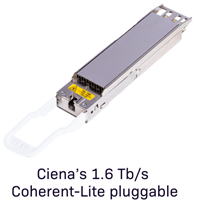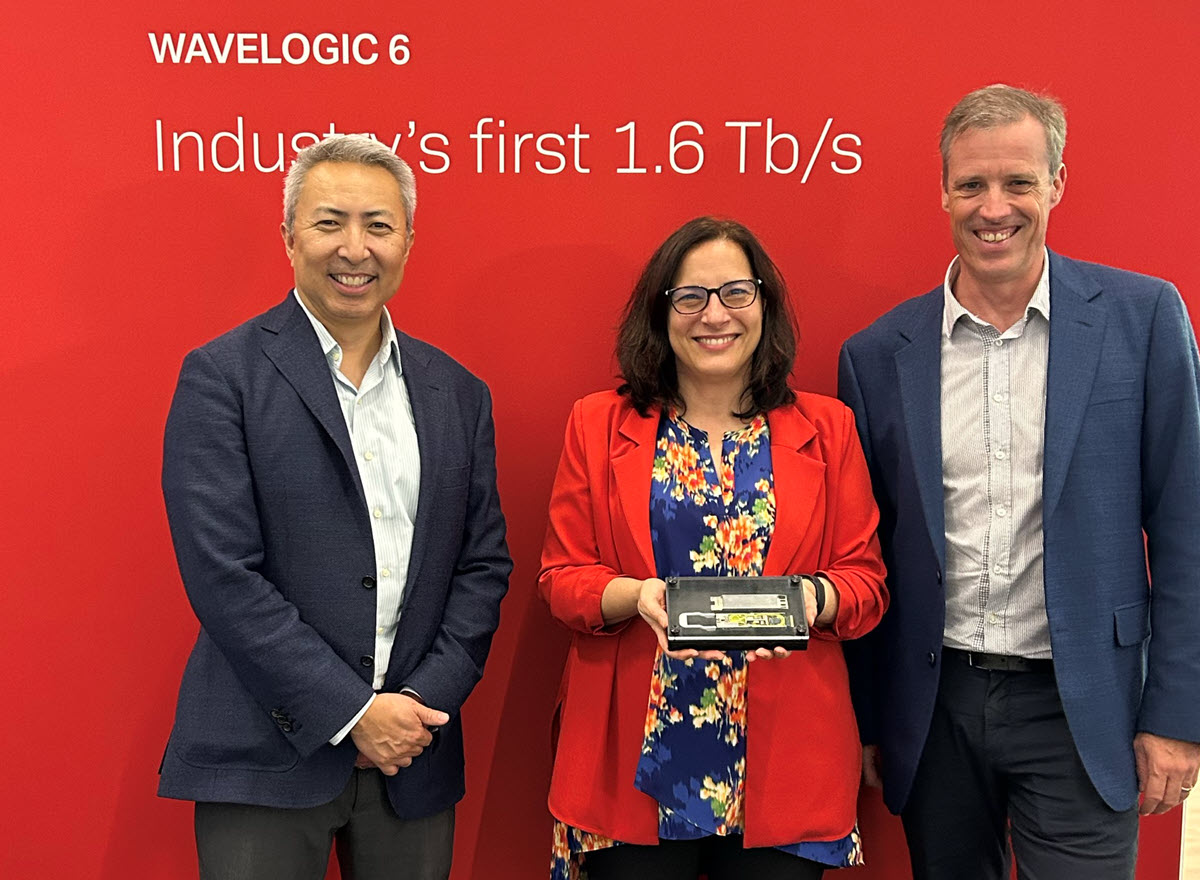Ciena's Helen Xenos explains the drivers and use cases of Ciena's 1.6T Coherent-Lite pluggable transceiver, the latest optical innovation from Ciena, powered by advanced 3nm CMOS.
 Global cloud and AI solution providers are challenging the industry for new innovations that can help scale network designs. You asked. We listened. Enter Ciena’s WaveLogicTM 6 Nano (WL6n) 1.6T Coherent-Lite pluggable, which is the first offering that brings coherent technology to data center applications. The 3nm coherent ASIC used in WL6n enables the 1.6T pluggable through support of 1.6TbE client support, 224G SerDes electrical lanes, and dual 800LR data paths within a single DSP chip.
Global cloud and AI solution providers are challenging the industry for new innovations that can help scale network designs. You asked. We listened. Enter Ciena’s WaveLogicTM 6 Nano (WL6n) 1.6T Coherent-Lite pluggable, which is the first offering that brings coherent technology to data center applications. The 3nm coherent ASIC used in WL6n enables the 1.6T pluggable through support of 1.6TbE client support, 224G SerDes electrical lanes, and dual 800LR data paths within a single DSP chip.
Why is a 1.6Tb/s pluggable needed, and what exactly is Coherent-Lite? Before we look forward, let’s look back to understand how we got here and what near-term challenges must be addressed.
The rapid adoption of AI applications is driving a significant increase in optical interconnects required inside and around the data center. Cloud and AI solution providers are looking to scale their AI clusters from tens of thousands of accelerators (GPUs, TPUs, etc, or generically xPUs) to over one million xPUs in the coming years. Optical Circuit Switch (OCS) fabric architectures are gaining traction for improved cost and power efficiencies as well as the ease of evolution to new technologies; this design also brings with it added signal impairments of higher loss and crosstalk, driving the need for higher performance interconnects.
In addition, massive scaling for new AI infrastructure consumes unprecedented amounts of power, resulting in the need to distribute compute between multiple locations, which is also driving the need for higher-performance interconnects. The highest speeds are desired, as they allow for scaling of data center designs with fewer connections. As line rates increase, the ability to achieve the performance (aka reach) required becomes increasingly challenging using traditional intensity modulated direct detect (IMDD) technology.
This technology challenge is something we at Ciena are familiar with. In fact, the industry encountered a similar situation almost 20 years ago with wide area networks. Back then, our experts came together to explore alternative ways of providing highly cost-effective and high-capacity transport beyond 10Gb/s line rates. Their innovative thinking resulted in the introduction of coherent technology.
Since then, coherent optical technology has become the cornerstone of long-haul, metro, and data center interconnect networks. Inside the data center, direct detect technology, particularly for its lower power characteristics, has been the technology of choice.
As capacity scales to higher rates and direct detect technologies get more complex, consume more power, and encounter physical limitations, data center architects are evaluating the advantages of coherent solutions within and around the data center. But here, we are talking about a different kind of coherent – Coherent-Lite.
 What is Coherent-Lite?
What is Coherent-Lite?
Coherent-Lite refers to power- and latency-optimized coherent designs intended for shorter reach, data center fabric (2km), and campus (up to 20km) applications. As we get to these higher 1.6T line rates, the power consumption of coherent and IMDD designs starts to converge. Moreover, Coherent-Lite has significant performance benefits over IMDD: it delivers a higher loss budget, can mitigate for crosstalk, and scales to higher capacity/fiber with WDM. Let’s take a look at some examples.
Benefits of 1.6T Coherent-Lite for Campus Applications
For campus applications, Coherent-Lite delivers higher performance compared to IMDD. What does this mean? Users can extend low-latency 1.6Tb/s connectivity across longer distances, up to 10, and even 20 kilometers. Why is the longer reach important? This provides much needed flexibility to cloud providers who are looking to build new data centers near sustainable, cost-effective energy sources and are now able to extend the distance between data centers while still using latency-optimized high-speed interconnects.

In contrast to IMDD, Coherent-Lite can also scale to deliver higher fiber capacity using WDM: up to 6.4Tb/s on a single fiber pair using an O-band-based design, or up to 25.6Tb/s with a C-band design.

Benefits of 1.6T Coherent-Lite for Optical Circuit Switch
There is interest by some hyperscalers and AI solution providers to replace spine switches in data centers with optical circuit switches or OCS. The benefits of using OCS are improved power, cost, and availability, with the ability to evolve more simply to new technologies. However, building an OCS fabric does result in higher path loss, with the loss proportional to the OCS radix; the higher the port count, the higher the loss.
Using Ciena’s 1.6T Coherent-Lite design for this application delivers a 4dB+ higher loss budget than IMDD, as well as crosstalk mitigation. In practical terms, the higher margin offered with Coherent-Lite enables a more robust design and prevents the occurrence of link flapping possible with IMDD. The higher performance of Coherent-Lite also enables a larger OCS radix - more ports and longer paths - as it can support higher loss. This allows users to connect more xPUs across more paths in their existing environments, many of which are often laden with patch panels which increases loss budgets.

Finally, in contrast to IMDD, Coherent-Lite can also scale to deliver higher fiber capacity using WDM, up to 6.4Tb/s using O-band optics. To minimize the number of OCS ports used, a single fiber design can be implemented.

A new era of networking
With the massive growth in data center interconnects fueled by new AI architectures, new innovative approaches are needed to solve connectivity challenges within and around the data center. Ciena's latest optical innovation, 1.6T Coherent-Lite pluggable powered by advanced 3nm CMOS, enables longer, higher capacity optical interconnects, bringing new levels of scale and flexibility for data center designs.






